A good trolling motor battery is durable and can store a large amount of charge. How much energy a battery can store is measured in amp-hours. Trolling motor batteries are typically between 35 and 125 amp-hours. A more important number to look at when selecting a trolling motor is the reserve capacity. The reserve capacity measures how long the battery will last with a 25 amp discharge. Typical values for good deep cycle batteries are between 90 minutes and 260 minutes.
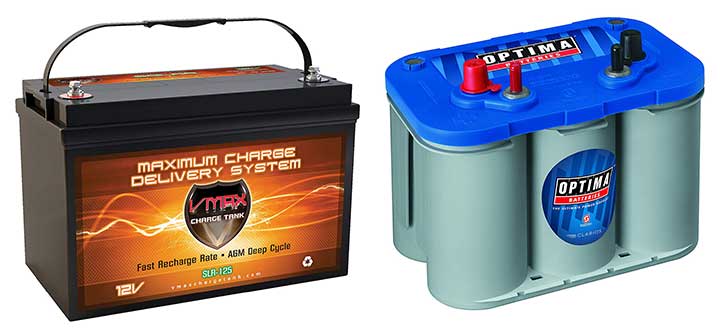
Battery weight is important when using small boats where it must be loaded and unloaded for each use. More information about battery requirements for specific trolling motors is included in this guide.
A battery not compatible with a trolling motor, such as a car battery, can actually cause harm to your trolling motor. Also, batteries that are designed for starting a car will only provide power for a short duration. Most deep cycle marine batteries can provide enough cold-cranking amps (CCA) to start the engine and store enough energy to run a trolling motor. If the motor is going to be used to start the boat engine make sure it has a high enough CCA value.
Absorbed Glass Mat (AGM) batteries
This type is the most costly option but comes with some distinct advantages over Wet-Cell batteries. Spending more on an AGM battery will grant you a much higher lifespan, generally lasting roughly four years. Some people claim the higher cost is worth the extended lifespan alone, due to the theory that you will need to buy half as many AGM batteries as Wet-Cell batteries over the course of several years.
AGM batteries are also completely sealed and do not require any maintenance other than proper storage. These batteries also dissipate power much less on average than wet-cell batteries. This allows them to hold their charge over long periods of time much better.
AGM batteries can also be called dry cell batteries, valve-regulated lead-acid, or non-spillable batteries. These are widely accepted as the best in overall performance for marine uses and if you have the extra money to spend, I highly recommend buying an AGM battery.
1. Optima D31M Deep Cycle AGM Marine Battery 75-Ah
| Estimated Price | $389 |
| CCA: | 900 Amp |
| Weight | 59.8-Pound |
| Reserve Capacity | 155-Min |
| Amp Hour | 75 Ah |
| Size L,W,H (Inch) |
12.81, 5.56, 9.38-Inch |
| Voltage | 12 Volts |
The Optima BlueTop Deep Cycle Marine Batteries are known to be one of the best marine batteries on the market. These batteries are durable and 15 times more vibration resistant than other batteries on the market. Also, the batteries last longer and can be charged up to three-time more than other deep cycle batteries.
Have a high cold cranking amp value the batteries can be used as the primary marine battery to start the boat. The batteries also have high amp-hour storage capacity and reserve capacity which is very important when running a trolling motor. Optima blue top batteries are sealed, spill-proof, matinee free and can be mounted in many positions. This is a great battery choice when it is used primary starting battery and to run electronics like a trolling motor, lights, speakers, and live wells.
2. Optima D27M Deep Cycle AGM Marine Battery 66-Ah
| Estimated Price | $395 |
| CCA: | 800 Amp |
| Weight | 53.8-Pound |
| Reserve Capacity | 140-Min |
| Amp Hour | 66 Ah |
| Size L,W,H (Inch) |
12.19, 6.81, 8.75-Inch |
| Voltage | 12 Volts |
This Optima D27M Deep Cycle battery is the in-between size for the blue top series. It has 66 amp-hours of storage. The amp-hour rating is done with a 5 amp battery discharge. It has a 140-minute reserve capacity. This rating is done with a 25 amp discharge and is a better specification for understanding battery life for trolling motors. Trolling motors typically require 30-50 amps at max power.
When looking at an optimum battery you notice the cylindrical cells rather than square flat plates of most deep cycle batteries. These are spiral-wound cells of lead with a lead oxide outer layer. The cells are tightly wound which is why they are so vibration resistant. There is an Absorbent Glass Mat separator that holds the electrolyte like a sponge making it less likely acid will spill.
3. Optima D34M Deep Cycle AGM Marine Battery 55-Ah
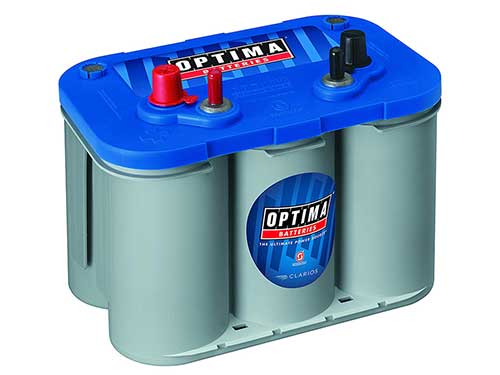
| Estimated Price | $309 |
| CCA: | 750 Amp |
| Weight | 43.5-Pound |
| Reserve Capacity | 120-Min |
| Amp Hour | 55 Ah |
| Size L,W,H (Inch) |
10.06, 6.88, 7.94-Inch |
| Voltage | 12 Volts |
Optima batteries do have two blue top battery versions. One has a dark gray case the other has a light grey case. The dark gray case is a starting battery and will not work well with trolling motors. The light gray case is a deep cycle marine battery that had suitable output power for starting the engine and for trolling motors.
I would recommend the blue top with the light grey case for all boating applications as lots of equipment on a boat requires power like marine radios, lights, fish finders, live wells, bilge pumps, downriggers, and electric fishing reels.
This battery, the D43M version with 750 cold-cranking amps, and a pack that weighs roughly 43.5 pounds. The posts are SAE 5/16-inch steel stud posts located on the top of the battery and since this is an Absorbent Glass Mat (AGM) it is virtually spill proof even if it gets knocked over.
This D31M contains 55 amp-hours of energy and has a reserve capacity of 120 minutes. Let us say you are running a 55-pound thrust trolling motor which draws about 40 amps at full throttle. This battery will last over 1 hour at full throttle. Even with a higher 80-pound thrust, two batteries would be wired in tandem so each battery would have about a 30 amp discharge and last almost two hours at full throttle. If you run the motor at high speeds for hours on end the Optima D31M would be a good option.
4. Bass Pro Shops Pro-Series AGM X-900 Marine Battery
| Estimated Price | $350-$430 |
| Group Size | 24, 27, 31 |
| CCA | 840, 930, 1150 Amp |
| Weight | 45, 60, 65-Pound |
| 24 Reserve Capacity | 160-min |
| 27 Reserve Capacity | 195-min |
| 31 Reserve Capacity | 220-min |
| Amp Hour | N/A Around 90, 110, 120-Ah |
| 24 Size L,W,H | 10.87,6.77, 8.75-in |
| 27 Size L,W,H | 12.44, 6.77, 8.75-in |
| 31 Size L,W,H | 13.00, 6.77, 9.78-in |
| Voltage | 12 Volts |
The Bass Pro Shops Pro-Series AGM X-900 are high capacity AGM Marine Batteries. These are dual-purpose with a cold craning amp value and a high reserve capacity. The exact amp-hours of these batteries but I listed the approximate values based on the reserve capacity. As I mentioned before the reserve capacity is the more important specification as this tested under conditions that more closely match amps used during trolling motor operation.
These batteries come in three sizes and have the highest storage capacity of any dual purpose marine batteries on the market. The cells are made with a high purity lead and hold power for over a year without needing to be charged. The batteries come with a free replacement 12-month warranty and a pro-rated 36-month warranty. These are sealed AGM cells that are shock resistant and leakproof. The battery also has a nice built-in handle for carrying and placing the battery in the hull.
5. Bass Pro Shops Pro-Series AGM Marine Battery
| Estimated Price | $200-$280 |
| Group Size | 22, 24, 27, 30 |
| CCA | 493, 545, 640, 773 Amp |
| Weight | 40, 56, 65, 72-Pound |
| 22 Reserve Capacity | 90-min |
| 24 Reserve Capacity | 120-min |
| 27 Reserve Capacity | 150-min |
| 31 Reserve Capacity | 190-min |
| Amp Hour | 55, 75, 90, 110-Ah. |
| 22 Size L,W,H | 10.87, 6.77, 8.75-in |
| 24 Size L,W,H | 10.87, 6.77, 8.75-in |
| 27 Size L,W,H | 12.44, 6.77, 8.75-in |
| 30 Size L,W,H | 13.00, 6.77, 8.75-in |
| Voltage | 12 Volts |
The Bass Pro Shops Pro-Series is a top-quality AGM deep cycle marine battery at a reasonable price point. These come in four sizes with the largest holding 110 amp-hours and has a reserve capacity of 190-minutes. These are great batteries as both the primary starting batteries and for trolling motor batteries.
Marine batteries have to be tough since boating environments tend to be rough. These batteries are impact-resistant, vibration resistant, sealed, and leakproof. There is an excellent 12-month free replacement warranty and a 36-month pro-rated warranty. The top of the batteries has a built-in handle which is really nice for carrying them.
6. Vmax Charge Tank Vmax 125 Amp Hour AGM Battery
| Estimated Price | $320 |
| CCA: | N/A |
| Weight | 75-Pound |
| Reserve Capacity | 260-min |
| Amp Hour | 125-Ah |
| Size L,W,H (Inch) |
12.9, 6.8, 8.7-in |
| Voltage | 12 Volts |
The Vmaxtanks Vmax is an AGM deep cycle battery with incredible storage capacity. It has 125 amp-hours of power and a reserve capacity of 260 minutes. This is higher than any other battery on this list. The only downfall is that this is not a good battery to use for starting boat motors.
This is a great batter to use as a stand-alone trolling motor battery. If the boat is used on an electric-only lake this is the battery to get. This battery will run most trolling motors for over three hours at full speed.
Vmaxtanks prides themselves on their military-grade design utilizing custom deep cycle plates. In float mode, you will get roughly 10 years of life which is much longer than any battery on the market. The AGM design ensures it is spill-proof and maintenance-free. It does weigh 75 pounds so it is not easy for many people to move around. However, there is a large carry handle built into the battery.
7. Vmax Charge Tank 100 Amp Hour AGM Trolling Motor Battery
| Estimated Price | $290 |
| CCA: | N/A |
| Weight | 68-Pound |
| Reserve Capacity | 200-min |
| Amp Hour | 100-Ah |
| Size L,W,H (Inch) |
12.1, 6.7, 8.2-Inch |
| Voltage | 12 Volts |
The Vmax Charge Tank is the 100 amp-hour version of the battery above. This battery also comes in a 50 amp-hour version with a reserve capacity of 100-minutes. The smaller battery only weighs 45 pounds which makes it easier to transport for many people. I would recommend getting the MinnKota power center which has a handle. The power center will even hold this large 100 amp-hour battery.
This is a group 27 deep cycle maintenance-free battery. It has one of the largest reserve capacity of deep cycle motors. This is not a dual-purpose batter and likely will not work to start boat engines. It is a good stand-alone battery to use for trolling motors or other power applications on the boat.
The video below shows how to wire trolling motor batteries in series.
8. Vmax Charge Tank 35 Amp Hour AGM Trolling Motor Battery
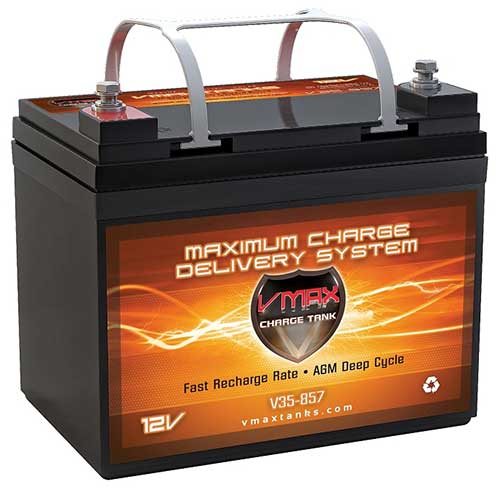
| Estimated Price | $118 |
| CCA: | N/A |
| Reserve Capacity | 75-min |
| Weight | 25.0 Pound |
| Amp Hour | 35-Ah |
| Size L,W,H (Inch) |
7.7, 5.0, 6.1-Inch |
| Voltage | 12 Volts |
This Mighty Max 35-Ah is quality small marine battery. The batter is not dual-purpose and can not be used to start a boat engine.
It is a sealed absorbed galss mat (AGM) battery that is maintenance-free. The battery can power small 30 thrust pound trolling motors for about 1 hour at full power. That is because the current draw is around 32 amps at full throttle for this size motor. The reserve capacity time is 75-minutes which is a time rating for a current draw of 25 amps. If it will be used for longer duration’s you will need a larger battery or have two batteries. When trolling on electric-only lakes I try and have more than one battery in case one dies. You know when a battery is losing its charge because the watercraft is moving much slower at full throttle.
This is a decent battery for a small trolling motor like the watersnake. The 24-pound trolling motor uses about 20 amps and the 18-pound trolling motor uses about 15 amps. This battery should last 75 minutes plus with of these motors. These batteries are not the best if you need to have the trolling motor powered on all day. However, if you are fishing on a small lake and only use the motor occasionally it could be perfect.
Small batteries like this are good for use with a Kayak or as a backup battery to get home if the primary battery runs out. It is better to have a backup battery than to have to paddle home. This AGM/SLA style battery pack is a sealed non-spillable lead-acid battery. It is also maintenance-free and mountable in any configuration. It also has a carry handle which is important for a portable battery.
I use a battery similarly to this to run lights when kayaking at night. This is shown in the above video, the deep cycle battery allows me to run 3 bright lights for over 10 hours.
9. Odyssey Trolling Thunder AGM Marine Battery
| Estimated Price | $370 |
| CCA: | 880 Amp. |
| Weight | 49.5-Pound |
| Reserve Capacity | 135-Min |
| Amp Hour | 68 Ah |
| Size L,W,H (Inch) |
13.25, 11.0, 9.5-Inch |
| Voltage | 12 Volts |
The Odyssey Trolling Thunder Marine Battery is a dual purpose mane battery. It contains stores 68 amp-hours of power with a reserve capacity of 135-minutes. It also has 880 cold-cranking amps which is more than enough to start most boat motors.
This battery has a great shelf life and can go up to two years without needing to be charged. It also works up to 400 cycles, which is very competitive against the other batteries in its price range and category. With this battery, you get the starting power, the trolling power, accessory power, and a long lifespan.
The motor is called trolling thunder because it is designed to be used with trolling motors. It is made with high purity lead plates is has an Absorbent Glass Mat to make it spill proof. The terminals are made with tin-plated brass witch is a great conductor and corrosion-resistant. This is a sealed design and is maintenance-free. Oddessey batteries have a high plate surface area and have very similar amp-hour ratings and reserve capacity as Optima spiral-would batteries.
Lithium Iron Phosphate Batteries
A newer option on the market is Lithium Iron Phosphate (LiFePO4) batteries. These batteries weigh less than half of lead-acid or AGM type batteries and have a higher reserve capacity for a given amp hour rating. They generally won’t work to start a motor though because they are not built to have high cold cranking amps.
The main advantages of lithium batteries include:
- Much lighter weight (about half the weight of lead-acid)
- Longer lifespan (up to 10 years or more)
- More charge cycles (around 3,000-5,000 compared to 300-500 for lead-acid)
- Can be stored at lower charge levels without damage
- Maintain consistent power output throughout discharge cycle
The main disadvantage is cost – they typically cost 2-3 times more than comparable lead-acid batteries. However, with their longer lifespan, they often work out cheaper in the long run.
10. Tracker Marine Lithium Iron Phosphate (New Battery Technology)
![]()
| Estimated Price | $500-$900 |
| Group Size | 24, 27, 31 |
| CCA | N/A |
| Weight | 15.9, 23.8, 29.8-Pound |
| 24 Reserve Capacity | 144-min |
| 27 Reserve Capacity | 192-min |
| 31 Reserve Capacity | 240-min |
| Amp Hour | 60, 80, 100 |
| 24 Size L,W,H | 10.2, 6.8, 8.2-in |
| 27 Size L,W,H | 12.0, 6.6, 8.6-in |
| 31 Size L,W,H | 13.0, 6.8, 8.8-in |
| Voltage | 12.8 Volts |
The Tracker Marine Lithium battery is a fantastic option to use for trolling motors. It weighs less than half of lead-acid or AGM type batteries and have a higher reserve capacity for a given amp hour rating. These will not work to start a motor though cause they are not build to have high cold cranking amps.
These can be put in series to run 24 volt or 36 volt trolling motor systems. Technically the voltage is 12.8 volts but these are intend to be used with trolling motors. Another huge advantage of this Lithuim battery is that it can last through 5,000 discharge styles compared to 350 or less with lead acid or AGM types. This battery can also be stored at 20 percent charge level without effecting the life of the battery. It is recommended to keep lead acid or AGM batteries fully changed.
If the price is the only think keeping you away from a Lithium marine batteries there are other options such as the Ampere Time brand which is reviewed below.
11. Battle Born 100 Amp Hour Lithium Iron Phosphate
| Estimated Price | $875 |
| CCA: | N/A |
| Weight | 31-Pound |
| Amp Hour | 100-Ah |
| Size L,W,H (Inch) |
12.7, 6.88, 9.0-Inch |
| Voltage | 12 Volts |
The Battle Born Deep Cycle Marine battery is one of a kind. It is a LiFePO4 battery with a 100 amp-hour storage capacity. This lithium-ion technology has an extremely long life expectancy. These are claimed to last 10 times longer than conventional batteries and come with a 10-year warranty.
The batter is 31 pounds and has the same storage capacity as a 68-pound lead-acid battery. This battery can deliver up to 100 amps output which is above what is needed for trolling motors. Make sure that the trolling motor is used with a 50 or 60 amp fuse. The batteries are made with 100 percent safe non-toxic material. This is a high-end battery and would good for application where high current, lightweight, and fast charge times are needed.
12. Ampere Time Lithium Iron Phosphate
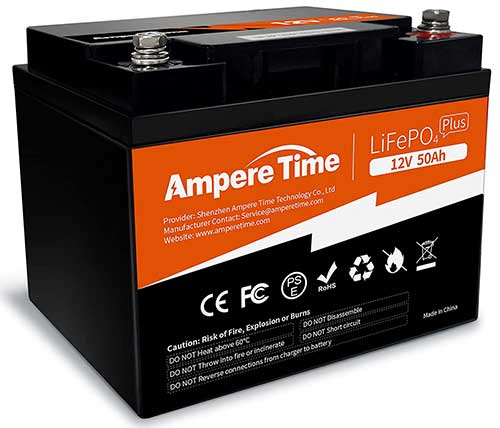
| Estimated Price | $290-$400 |
| CCA | N/A |
| Weight | 11.57, 24.25-Pound |
| Amp Hour | 50, 100 |
| 50 AH Size L,W,H | 7.79, 6.53, 6.69-in |
| 100 AH Size L,W,H | 13.0, 6.28, 8.48-in |
| Voltage | 12 Volts |
Ampere Time is a popular low cost Lithium Iron Phosphate marine battery. This battery will not start a boat engine but will run a trolling motor very well. Lithium batteries are gaining popularity due to there lightweight, high reserve capacity, and very large number of times it can be charged in discharged. The price is a bit higher up front but can be a much better value in the long run. It can last up to ten years and over 4,000 charge discharge cycles.
The Tracker Marine and Battle Born reviewed above were also Lithium Iron Phosphate deep cycle batteries. However Ampere Time is considerably lower cost. There does seem to be more and more companies starting to sell this type of battery. Ampere Time does not list the exact reserve capacity cause it is designed for many applications not just trolling motors were reserve capacity is standard metric to compare batteries. The Tracker Marine 100 amp hour Lithium battery has a reserve capacity of 240 minutes. This brand could be similar but I could not say for sure since it is not listed.
The Lead-Acid Wet-Cell Battery
These batteries now represent only about 15-20% of the marine battery market, though they were once the standard. Their continued presence is almost entirely due to their significantly lower price point compared to AGM or lithium alternatives. While they have been designed to handle frequent charging and discharging cycles, they’re increasingly being replaced by maintenance-free options.
Despite being the most economical option available, wet-cell batteries come with several notable drawbacks. You’ll need to periodically check and top off the water inside the battery to keep the charge plates fully submerged. These batteries are also prone to spillage, especially in rough waters, creating potential hazards on your boat. The maintenance requirements and safety concerns explain why many boaters choose to invest in sealed options despite the higher cost.
Some wet-cell batteries now come in maintenance-free versions that don’t require regular water additions. These are a bit more expensive but offer improved convenience. If you’re fishing on a budget or only need a battery for occasional use, a standard wet-cell battery remains a practical option, but understand that you’re trading some convenience and safety for the lower price point.
13. Universal 100 Amp Hour Lead Acid Battery
| Estimated Price | $225 |
| CCA: | N/A. |
| Weight | 63.9-Pound |
| Reserve Capacity | About 165-min |
| Amp Hour | 100-Ah |
| Size L,W,H (Inch) |
12.2, 6.61, 9.2-in |
| Voltage | 12 Volts |
This Universal batter is a deep cycle battery. It is not a dual-purpose battery that can be used to start an engine. This battery is reasonably priced for a 100 amp-hour battery. The reserve capacity is not as high as other 100 amp-hour batteries but is comparable to other batteries that weigh around 64 pounds.
Universal Power Group has been making batteries since 1968. There is a one year warranty for this battery. It is a non-spillable sealed lead acid battery. It comes with a carry handle which is very important. This battery is not built as tough as other batteries on this list. If it is just used for occasional use on calm lakes it should bet the job done.
14. Mighty Max 55 Amp Hour Lead Acid Battery
| Estimated Price | $120 |
| CCA: | N/A. |
| Weight | 36.3-Pound |
| Amp Hour | 55-Ah |
| Size L,W,H (Inch) |
9.02, 5.43, 9.13-Inch |
| Voltage | 12 Volts |
The mighty max is a maintenance-free sealed lead-acid battery. This is a sealed non-spillable battery and can be mounted on its side. The battery is not for dual purposes and can not be used to start an engine. It does have a 55 amp-hour capacity and will work with trolling motors.
This is not a top-quality battery but is reasonably priced. At just 36 pounds it would be good to use in a kayak or small boat. For a 55 amp-hour battery it is quite light at just 36.3 pounds. This would be a good batter for trolling motors that are 40-pound thrust and under. It would also be a good back up-battery to have on a boat in case the primary battery dies. For motorboats, a dual-purpose batter would be better as a back-up since it can be used to start the main engine as well.
15. Interstate Sealed Lead Acid Deep Cycle Lead Acid Battery
| Estimated Price | $175- $230 |
| CCA: | N/A |
| Weight | 37, 49-Pound |
| Amp Hour | 55, 75-Ah |
| Size 55 L,W,H | 9.02, 5.43, 8.27-Inch |
| Size 75 L,W,H | 10.24, 6.61, 8.19-in |
| Voltage | 12 Volts |
Interstate batteries are well known for their traditional wet cell deep cycle marine battery. This particular battery is a 35 amp-hour AGM battery. It also comes in a 100 amp-hour size. The 35 amp-hour battery weighs just 22.9 pounds and works well in kayaks and small boats.
This is a sealed non-spillable lead-acid AGM battery that is maintenance-free. It comes with a handle wish is important and the handle is removable if desired. The battery is not a dual purpose and will not start the boat engine. This is a good battery for used just for the trolling motor other electronics separate from the main engine.
Battery Boxes and Protection
While not essential, a battery box can be a valuable addition to your trolling motor setup, especially for smaller boats or kayaks. Battery boxes serve several important functions:
- Protection – They shield your battery from water, dirt, and physical damage
- Transportation – Many include handles for easier carrying
- Connections – Some include built-in connection points and circuit breakers
- Safety – They help prevent accidental shorts and contain potential spills
I’ve found that quality battery boxes, like the Minn Kota power center, make the whole experience of using a trolling motor more convenient and safer. They’re especially useful if you frequently need to remove your battery for charging or storage.
Minn Kota Trolling Motor Battery Center Box
| Estimated Price | $65 |
| Weight | 3-Pound, Max 75-pound |
| Size L,W,H | 17, 10, 12-in |
| Interior Size L,W,H | 13-3/8, 7-3/8, 8-3/4-Inch |
| Voltage | 12 Volts |
The Minn Kota trolling motor power center is not a battery but is a very popular way to use a battery on a small boat. This box serves a few purposes. Most importantly it protects the battery. As many of you know batteries can get very dirty and corroded if not properly protected. This can affect battery performance and life. Second, the box is a good way to transport a batter as it has a carry handle.
It also serves as an easy way to connect the battery terminals and other electronics to the battery. There are two 12-volt accessory ports to charge handheld electronic devices. Lastly, the box has a 10 amp circuit breaker for the accessory ports and a 60 amp circuit breaker for the trolling motor. This box is designed to work with trolling motors. It is perfect for boats that do not have a battery compartment or use the battery as an addition to the primary starting battery.
Understanding Trolling Motor Battery Types
For trolling motor batteries the important thing is that it is a deep cycle battery with a high storage capacity. Storage capacity is measured in terms of amp-hours or as a reserve capacity in minutes. The reserve capacity is determined by draining the battery at 25 amps discharge rate. While the amp-hour is calculated by draining the battery at a 5 amp discharge rate.
This slower discharge rate is commonly called the 20-hour rate and is a standard way to measure amp-hours. However, the slower a battery is discharged the higher the amp-hour rating will be. Trolling motors use a high 30-50 amp discharge at full throttle and for this reason, the reserve capacity actually provides more insight into battery usage capacity than the amp-hour value.
There are two types of deep-cycle batteries. Some are dual-purpose and can be used to start the boat engine and run the trolling motor. Other deep cycle batteries do not have high cold cranking amps and can only be used to run the trolling motor and lower current electronics.
Deep Cycle Battery
These batteries are designed to be used under a steady load and have the capability of being used until most or all of its capacity is discharged. They typically come in the same form factor as what you’d expect to see a car battery to appear as, but don’t be fooled, how they discharge and how they work are completely different.
Marine Battery
First and foremost, it’s important to note that you can find marine batteries in three different categories: Starter, deep cycle, and dual purpose.
A starter marine battery is similar to what a car battery would be with the capability of cranking a boat motor. These are not what we are looking for to power our trolling motors, so steer clear of marine batteries that are purpose-built for starting a motor. Furthermore, if you do use these during an emergency situation to power your trolling motor, despite the danger of damage, you’ll get a very low amount of time to use the battery until it no longer has the capabilities to provide steady power output.
A deep cycle marine battery is basically identical to deep cycle batteries, just that they are built specifically for usage with trolling motors and perhaps other boating-related applications such as running your GPS, fish finder units, spotlights, etc. These batteries allow the user to utilize pretty much all of the power inside the battery pack, meaning your trolling motor will be capable of using nearly 100% of the power the battery has to offer.
Again, a dual purpose marine battery is essentially the same as a regular dual-purpose battery, except it may come in a form factor more viable for use out on the water.
Dual Purpose Battery
A dual-purpose marine battery would be capable of both starting your boat’s motor and providing steady power to the trolling motor. While it would be nice to have a specific battery for each of the use cases, a dual-purpose battery works pretty well at doing both. It is common to use deep cycle marine batteries that are dual-purpose on boats. Even if there is not a trolling motor on the boat there are lots of other electronics that are powered off the battery.
Since dual-purpose batteries are capable of providing power in both a heavy output and a steady output, they are versatile, but there is a small tradeoff in performance. Generally, these batteries will not have the same capability at lower levels of charge and will generally stop providing power or crank capabilities once they are discharged to low levels. Don’t be surprised if your battery has 20 percent power left but cannot run the trolling motor or cannot crank the boat’s motor.
Car or Starting Battery
Do NOT ever use a car battery or anything similar to that on a trolling motor. This may work temporarily if you are in an emergency situation. However, you will greatly reduce the life and could damage the electronic internals of your trolling motor. Car batteries are not meant to provide steady power output but instead, are built to provide a massive power jolt has to crank a large motor. Car batteries also degrade quickly when discharged to low levels. This means you will not only damage your trolling motor but you will also greatly reduce the life of the car battery too.
Trolling Motor Battery Types
For trolling motor batteries the important thing is that it is a deep cycle battery with a high storage capacity. Storage capacity is measure in terms of amp-hours or as a reserve capacity in minutes. The reserve capacity is determined by draining the battery at 25 amps discharge rate. While the amp-hour is calculated by draining the battery at a 5 amp discharge rate.
This slower discharge rate is commonly called the 20-hour rate and is a standard way to measure amp-hours. However, the slower a battery is discharged the higher the amp-hour rating will be. Trolling motors use a high 30-50 amp discharge at full throttle and for this reason, the reserve capacity actually provides more insight into battery usage capacity than the amp-hour value.
There are two types of deep-cycle batteries. Some are dual-purpose and can be used to start the boat ending and run the trolling motor. Other deep cycle batteries do not have high cold cranking amps and can only be used to run the trolling motor and lower current electronics.
Deep Cycle Battery
These batteries are designed to be used under a steady load and have the capability of being used until most or all of its capacity is discharged. They typically come in the same form factor as what you’d expect to see a car battery to appear as, but don’t be fooled, how they discharge and how they work are completely different.
Marine Battery
First and foremost, it’s important to note that you can find marine batteries in three different categories: Starter, deep cycle, and dual purpose.
A starter marine battery is similar to what a car battery would be with the capability of cranking a boat motor. These are not what we are looking for to power our trolling motors, so steer clear of marine batteries that are purpose-built for starting a motor. Furthermore, if you do use these during an emergency situation to power your trolling motor, despite the danger of damage, you’ll get a very low amount of time to use the battery until it no longer has the capabilities to provide steady power output.
A deep cycle marine battery is basically identical to deep cycle batteries, just that they are built specifically for usage with trolling motors and perhaps other boating-related applications such as running your GPS, fish finder units, spotlights, etc. These batteries allow the user to utilize pretty much all of the power inside the battery pack, meaning your trolling motor will be capable of using nearly 100% of the power the battery has to offer.
Again, a dual purpose marine battery is essentially the same as a regular dual-purpose battery, except it may come in a form factor more viable for use out on the water.
Dual Purpose Battery
A dual-purpose marine battery would be capable of both starting your boat’s motor and providing steady power to the trolling motor. While it would be nice to have a specific battery for each of the use cases, a dual-purpose battery works pretty well at doing both. It is common to use deep cycle marine batteries that are dual-purpose on boats. Even if there is not a trolling motor on the boat there are lots of other electronics that are powered off the battery.
Since dual-purpose batteries are capable of providing power in both a heavy output and a steady output, they are versatile, but there is a small tradeoff in performance. Generally, these batteries will not have the same capability at lower levels of charge and will generally stop providing power or crank capabilities once they are discharged to low levels. Don’t be surprised if your battery has 20 percent power left but cannot run the trolling motor or cannot crank the boat’s motor.
Car or Starting Battery
Do NOT ever use a car battery or anything similar to that on a trolling motor. This may work temporarily if you are in an emergency situation. However, you will greatly reduce the life and could damage the electronic internals of your trolling motor. Car batteries are not meant to provide steady power output but instead, are built to provide a massive power jolt as to crank a large motor. Car batteries also degrade quickly when discharged to low levels. This means you will not only damage your trolling motor but you will also be greatly reducing the life of the car battery too.
Battery Output and Capacity
This one is tough because there are several different standards a manufacturer could use to explain their battery’s output and capacity levels. You may see CCA, CA, MCA, HCA, AH, or RC as a unit of measurement.
Cold Cranking Amps (CCA) measures the number of amps a battery is capable of implementing at zero degrees Fahrenheit over the course of 30 seconds while not dipping under 7.2 volts. High CCA means the battery is especially good for cranking over a motor. This is important when using the battery to start the engine. If the battery will be used both as a trolling motor battery and starter battery make sure there is a CCA value, usually 750 amps or higher.
Cranking Amps (CA) is essentially the same thing as CCA but measured at a temperature of thirty-two degrees instead of zero.
Marine Cranking Amps (MCA) is basically the same idea as CA but formally used on marine-specific batteries. This test is also done at thirty-two degrees Fahrenheit.
Hot Cranking Amps (HCA) is essentially the same thing as CCA but measured at a temperature of eighty degrees instead of zero.
Amp-Hour (AH) is the most common rating used for deep cycle batteries. This measurement display is standardized in what is called the 20-hour test. This is actually done by draining the battery at 5 amps. So a 50 amp-hour battery would drain in 10 hours but it is still the 20 hour test rate.
Reserve Capacity (RC) is a measurement in minutes that a completely charged battery can discharge 25 amps continually at eighty degrees until the battery drops below 10.5 volts. This value provides greater insight into how long the battery will last for trolling motors.
Battery Maintenance and Care
The batteries used to power your trolling motor are fine pieces of engineering and require some love and care. In return for extra attention, you will get significantly more bang per buck in the form of longevity, durability, and performance. The types of batteries I mentioned above have slightly different methods of maintenance so pay attention to which type you have and follow the instructions carefully.
First and foremost, a brand new battery needs to be topped off before use. Charge it up to 100 percent the first time you plug it in without any pauses, breaks, or usage in the charging cycle. New batteries have usually been used at least once before you get them, generally as a manufacturer’s test, which means they most likely have a complete charge cycle on them already and may even be close to 100%.
With that said, we can not know for sure. There is a chance the battery has never been charged to the max before. In this case, the battery performance would be reduced by immediately discharging it. Charge it up to 100 percent out of the box each and every time you get a new battery and you’ll never need to worry, with the guarantee it’ll be at its top performance level.
Experts recommend cycling the battery 20-50 times down to the 50% area and back up to 100% to create a sort of battery memory and extend their lifespans. Batteries that are completely discharged in a “new” state often have trouble reaching 100% again, greatly reducing your future capacity and performance.
Battery Charging Maintenance
Remember, batteries should be charged to 100% each and every time anything pulls any amount of power from them, no matter how much they were used. In theory, even if you were to hook up a small lightbulb and power it for a minute Ideally the battery should be topped off at 100 percent again. Some anglers may leave their batteries uncharged after a day on the lake because they did not use the trolling motor much. If you want your batteries to survive and perform well it is good to charge the battery each time it is used.
Undercharging causes stratification, which basically means the internals of the battery is being damaged. Overcharging causes gassing, which results in the water rapidly evaporating. This could leave the plates exposed and allowing heat to build up, causing stratification. Never charge a battery at temperatures above 120 degrees.
If you have a wet-cell that isn’t sealed, you’ll need to water them like a plant. If the plates inside the battery are not fully submerged from the factory, you’ll need to add water. The water should exceed the plates by roughly one-eighth inch. Since there are many different types, form factors, sizes, etc, this is a general estimate. The user manual should be used to determine the exact level. Distilled water should be used only and you should never overwater.
Battery Storage and Long-Term Maintenance Tips
If you have a series of batteries, and one battery goes bad, it’s ill-advised to replace one part of the series with a brand new battery. Batteries in a series work together to provide power. In the case of deep cycle batteries, a brand new battery paired with one or more used batteries would likely lead to the new battery’s performance being greatly diminished. The older battery could also fail to keep up and wear out even faster.
If storing batteries, never store them discharged and if possible, keep them above 80 percent at all times. A battery that is used under 80 percent is trading in some of the longevity for longer used times.
The age-old myth of batteries being affected by being sat or stored on a concrete floor is not true. If a battery freezes, however, the battery will most likely be severely damaged beyond repair. Keeping the battery charged will protect it from freezing in most cases. On the flip side, heat above eighty degrees will accelerate the battery’s discharge attributes. Extreme temperatures can also damage the internals of the battery.
As a final note, battery maintenance changes as they age. Age can be in the form of years after manufacturing or cycles. A battery that is several years old or has a lot of cycles on them will naturally degrade and require longer charging times for less capacity. Old batteries may require more frequent watering, and a higher amperage to achieve the end of their charging cycle. Furthermore, the rods inside the battery will degrade and performance will diminish exponentially.
Calculating Battery Run Time
Go back to the user manual or the product page for the trolling motor and figure out how much amperage draw (AD) that battery is going to use. The more powerful the unit is, the more amperage it’s going to need to perform.
After you have that figured out, it is time to do a little math. Since trolling motor batteries are rated in amperage per hour (AH), we can do a little number crunching to figure out what we’re looking for.
The equation we need looks like this: AH / AD = run time. So, for example, if we have a 55-pound thrust trolling motor that draws 40 amps at full power, and a 100 amp-hour battery, we get 100/40 = 2.5 hours of theoretical run time.
The amperage draw value is for max throttle. This would be the case if the trolling motor is used as the primary means of movement. In most cases, the trolling motor is used at partial throttle requiring much less power. Also, note the amp-hour rating is at 5 amp discharge so actual amp-hours when used at higher discharge rates will be lower. The reserve capacity provides good insight into how long a trolling motor battery will last.
Common questions about marine batteries.
What is the best battery for a Minn Kota trolling motor?
The best battery for a trolling motor is any deep cycle marine battery with a high amp-hour rating and high reserve capacity. An example of a good battery is the Optima D31M which has 75 amp-hours and 155 minutes of reserve capacity. It also has 900 cold-cranking amps and can start most boat engines with a single battery.
The latest marine batteries hold the electrolyte in an Absorbent Glass Mat. This makes them spill-proof and maintenance-free.
Lastly, if the trolling motor battery is not stored in the battery compartment of the boat it is good to use a Minn Kota battery box. This protects the battery, provides a handle to move the battery, provides an inline fuse, and makes it easy to connect the trolling motor leads.
What size battery do I need for a 55 lb thrust trolling motor?
An average 55-pound thrust trolling motor draws a max current of around 40 amps. This means that a 40 amp-hour battery will last about one full hour of full-throttle trolling. A 100 amp-hour trolling motor battery would last about 150 minutes of trolling. Based on how much and how long the trolling motor battery will be used will determine how big and how many batteries are needed. It is not uncommon to have three trolling motor batteries on a boat that frequently uses the trolling motor.
How long will a 12v battery run a trolling motor?
How long the trolling motor will last is not dependent on the number of volts. It depends on how much current draw the motor uses at different power settings. The best number to estimate how long a trolling motor battery will last is by looking at the reserve capacity. This value is how long the battery will last with a 25 amp current draw. Small 30-pound thrust trolling motors uses about 30 amps at full throttle, so it will run the motor for slightly less time then the reserve capacity rating. This does assume the motor is consciously being used at full throttle. Large 80-pound thrust trolling motors require about 50 amps at full throttle so the battery would last about half as long as the stated reserve capacity.
Can I use a car battery for a trolling motor?
No, car batteries are not good to be used with a trolling motor. This is for three reasons. First car batteries are made to provide shore high current bursts of energy. The total amount of power the battery stores is quite low. Trolling motor requires lots of power and a deep cycle battery is a much better option. Second, car batteries can send too much current to the trolling motor damaging electronic components within the unit and even the motor itself. Finally, a car battery should not be drained to a low value. If a car battery completely dies and is then recharged it damages the cells reducing the battery’s performance and life duration.
How often should I charge my trolling motor battery?
The trolling motor battery should be charged after each use. It is better to not let the battery go down all the way to zero charge. This can reduce the performance of the battery. It is best to store the battery at full charge.
When a trolling motor battery is connected to the primary motor the battery charges while the engine is running. If the trolling motor is used much more than the primary engine the battery should still be charged after each use.
What is the best-rated marine battery?
The best marine batteries are the Optima BlueTop deep cycle marine batteries with a light gray case. These are dual-purpose batteries that can start a large engine and store lots of charges to run boat electronics like fish finders, marine radios, electric fishing reels, downriggers, lights, speakers, and electric trolling motors. These are sealed maintenance-free batteries that are spill-proof.
What is a deep cycle marine battery amp hour rating mean?
The amount of energy stored in a marine battery is measured in amp-hours. The standard way this is done is to dissipate the battery at 5 amps until it drops below 10.5 volts. This standard method is called the 20 hours rate. For example, a battery that can provide 5 amps for 20 hours would have a rating of 100 amp-hours. For trolling motors, the battery load is typically higher than 5-amps so the actual amp-hours will be less than the battery says.
What is a battery reserve capacity?
The battery reserve capacity is the most accurate way to measure how much energy is in a deep cycle battery. This is measure by draining the battery at 25 amps until the battery drops below 10.5 volts. Typical values for deep cycle marine batteries is between 60 minutes and 260 minutes. The higher the number the longer the battery will last.
While the 25 amp load is not an exact measurement of what will be used it is a higher load than what is used to calculate amp-hours. The amp-hour value can make people think the battery will last longer than it will. Batteries for marine applications often require a large sustained power draw. Selecting a battery with the largest reserve capacity will provide power for the longest duration. If the battery is used to start the engine make sure it also has a high cold cranking amp value.
Captain Cody has worked on charter fishing boats in the Florida Keys, Virgin Islands, and Alaska. Growing up in Pennsylvania Cody has also done extensive freshwater fishing including bass fishing tournaments. Cody strives to provide detailed information about the best fishing gear and tactics to help both novice and experienced anglers have a more productive and enjoyable time on the water. Cody also has a background in aerospace engineering and neuroscience but really only takes pride in being good at one thing and that is fishing!

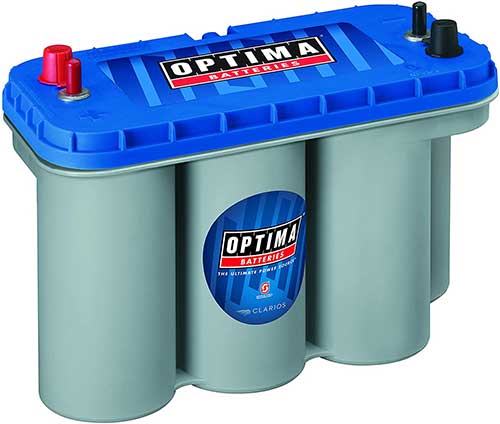


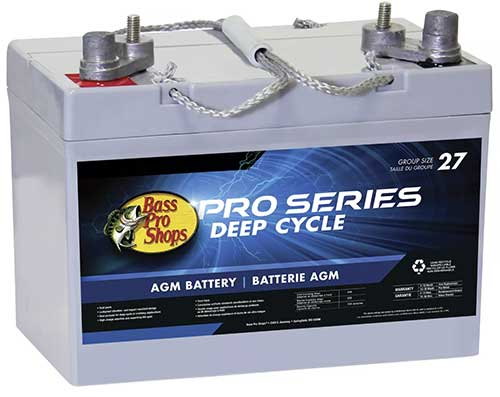
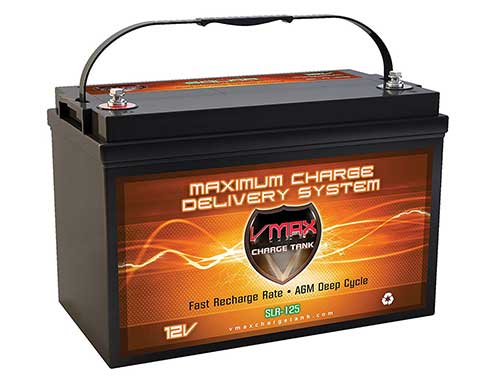
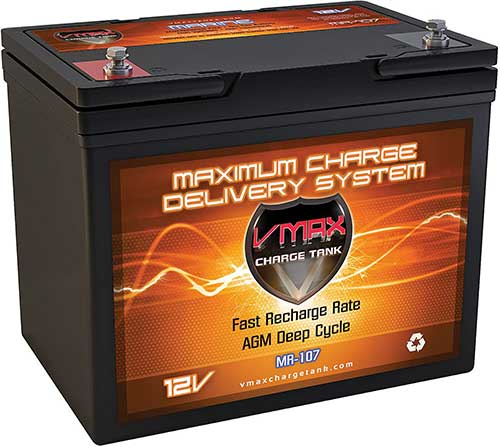

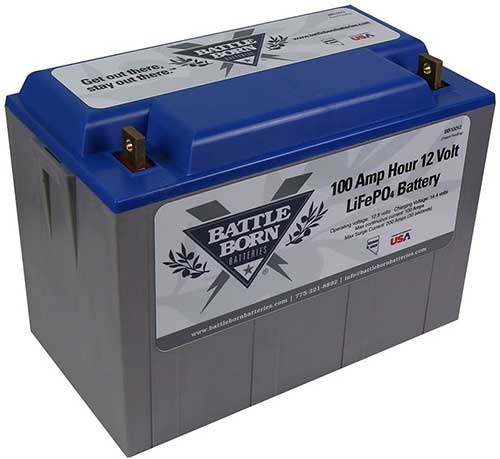

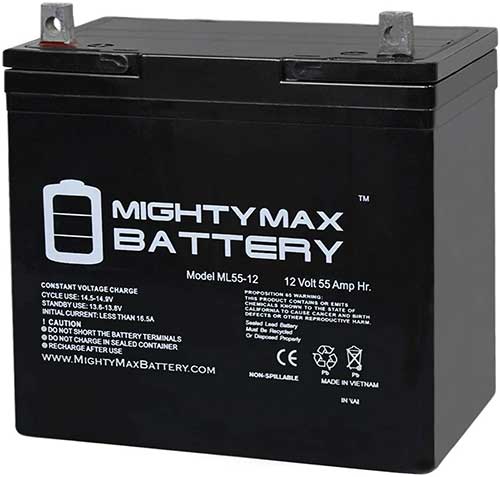
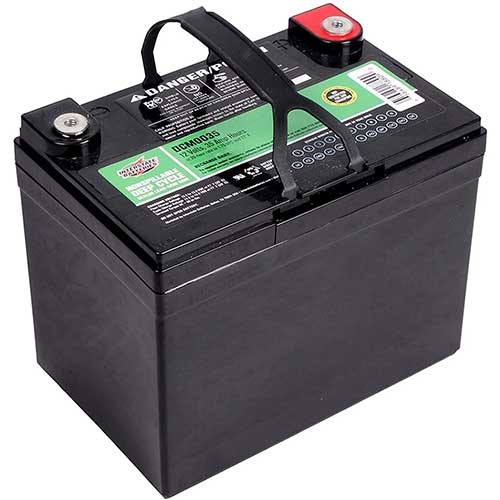
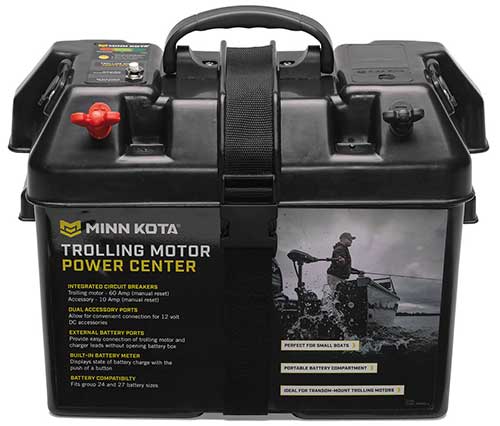
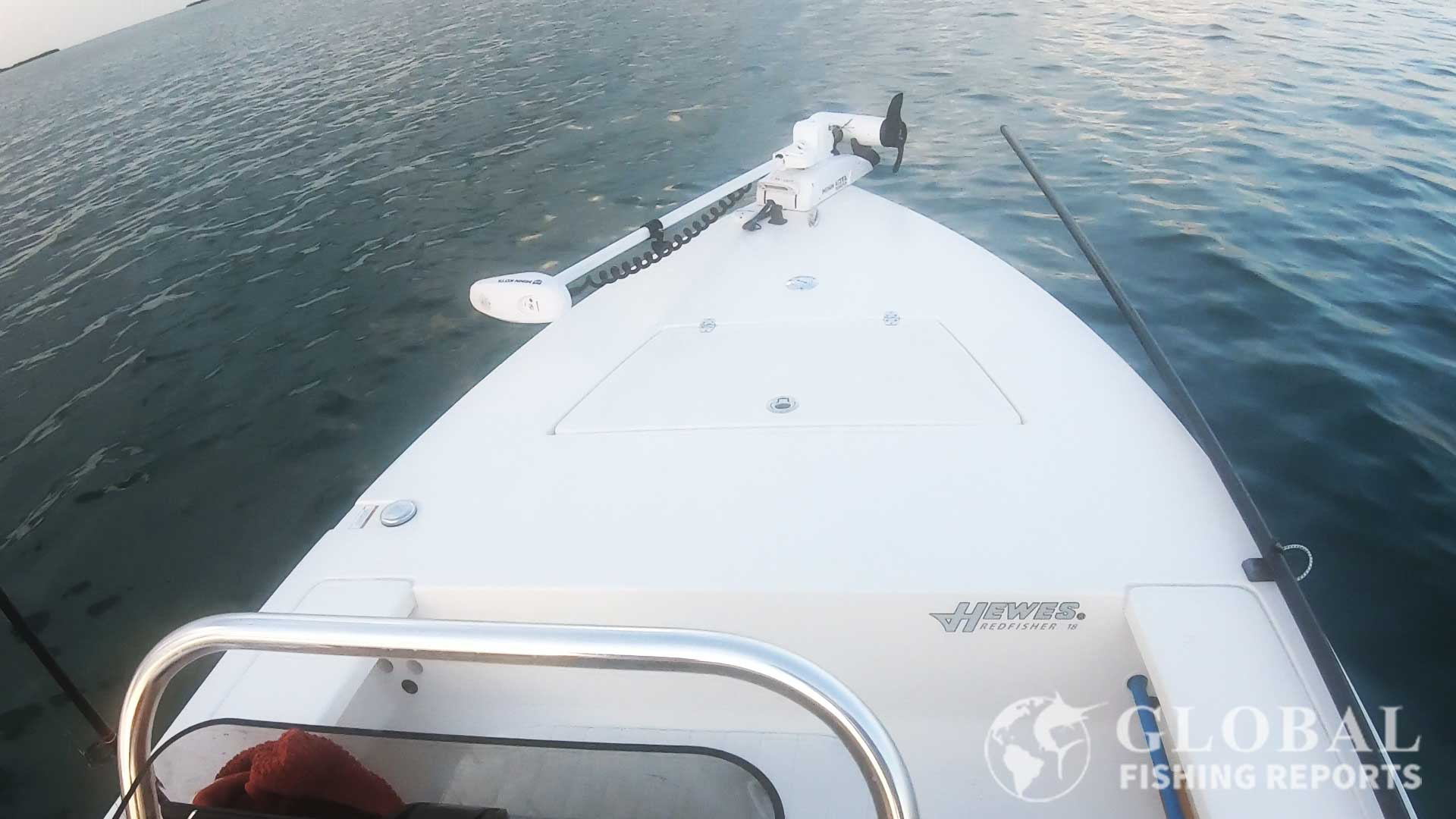
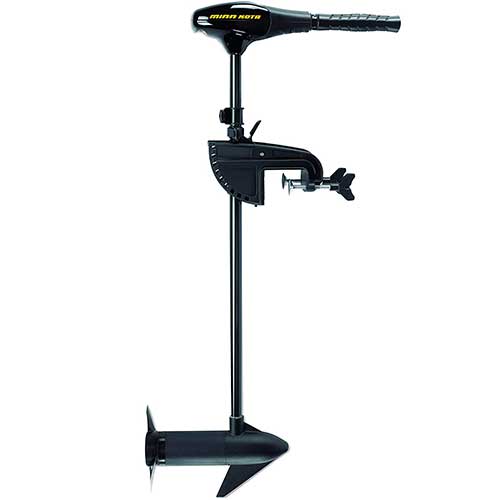

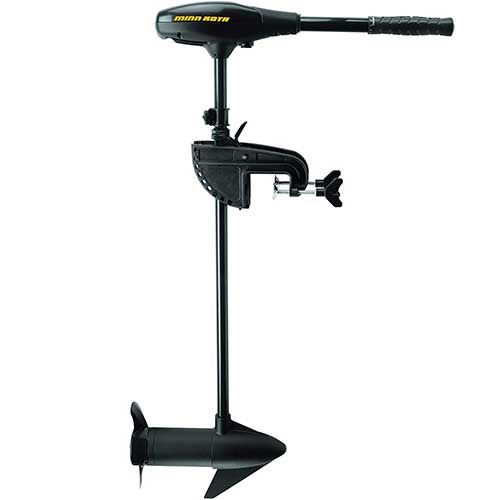
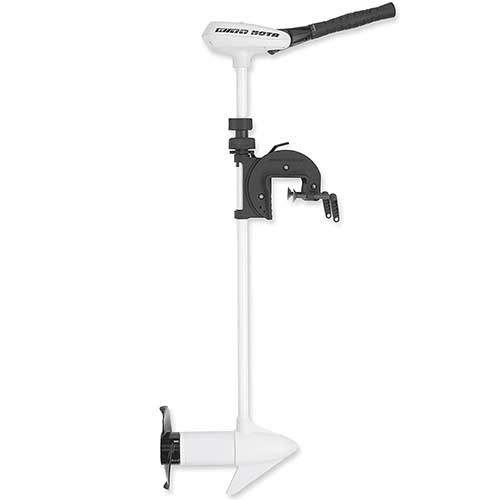

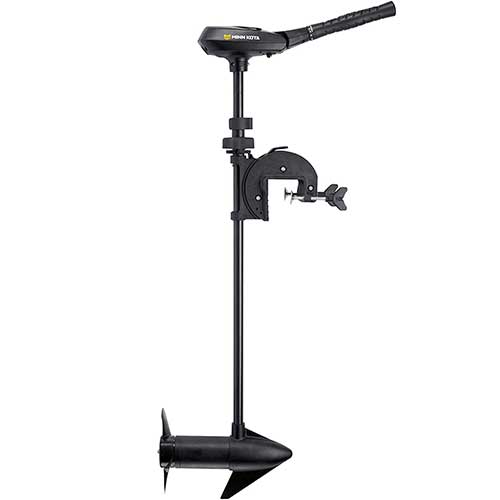
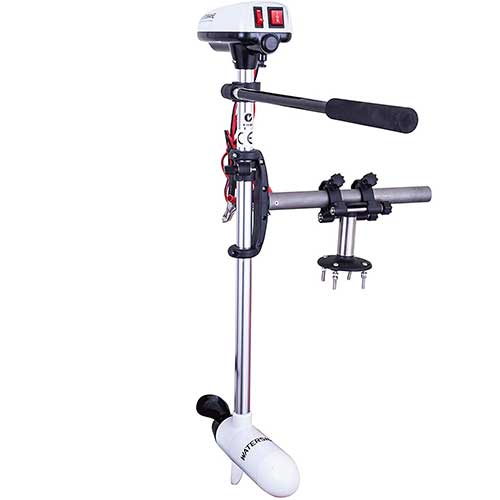
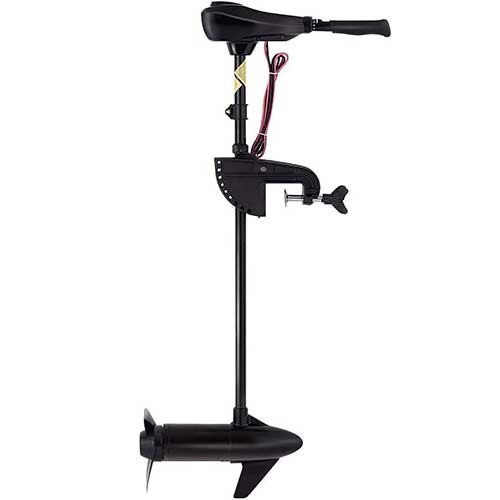
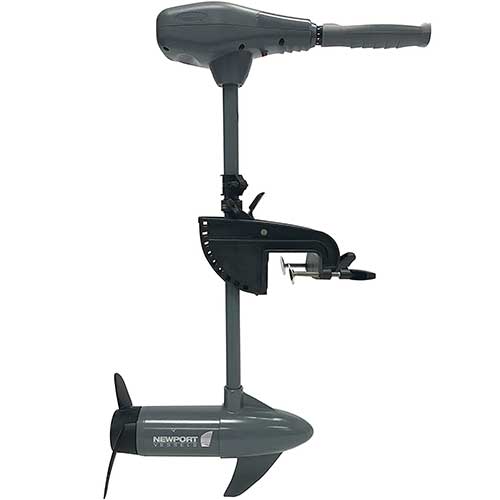
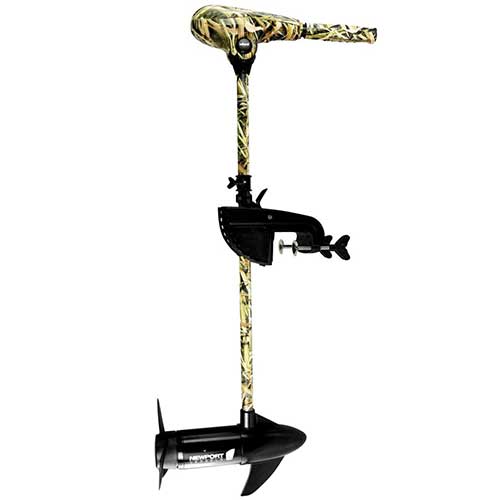
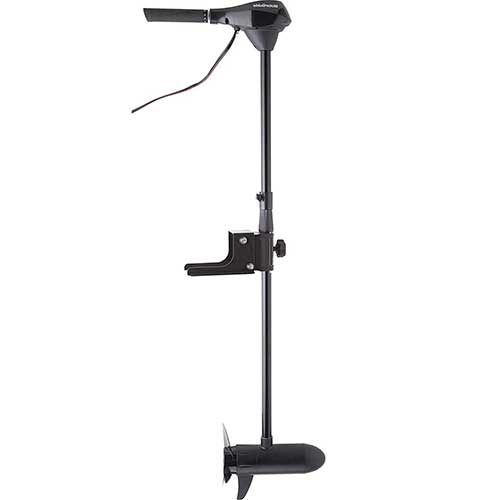
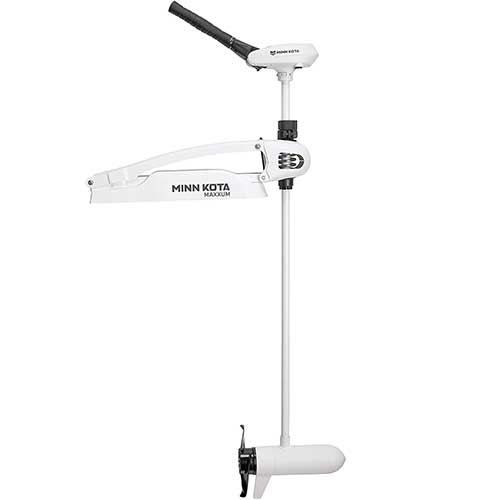
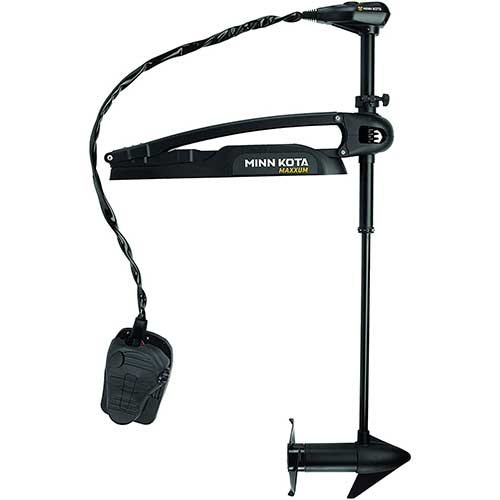

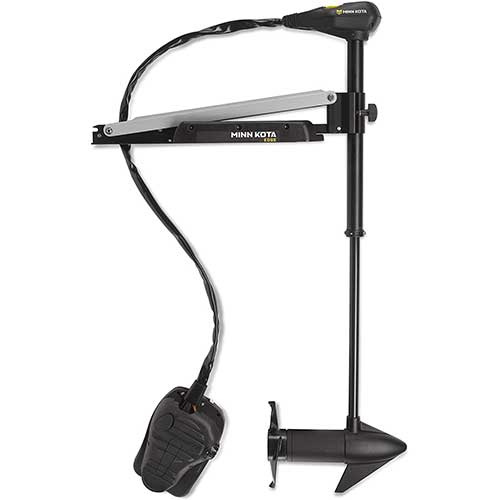
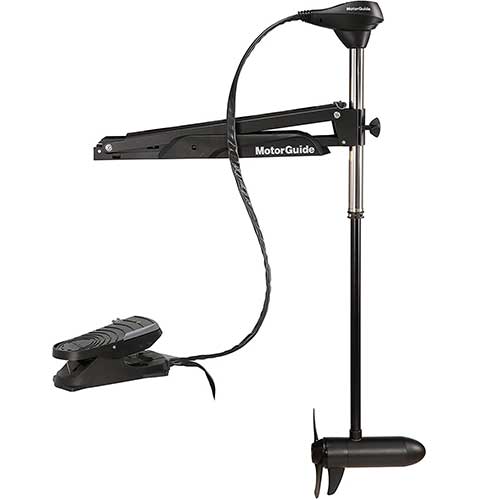
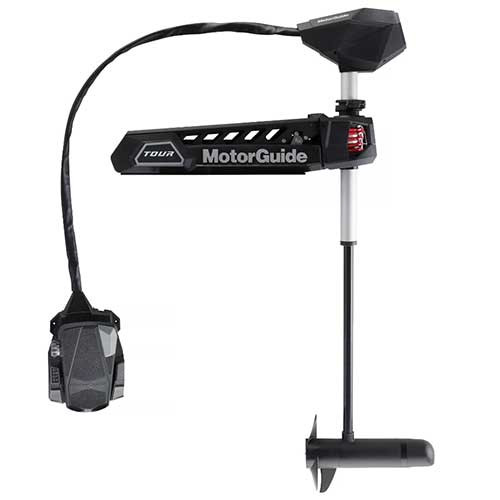

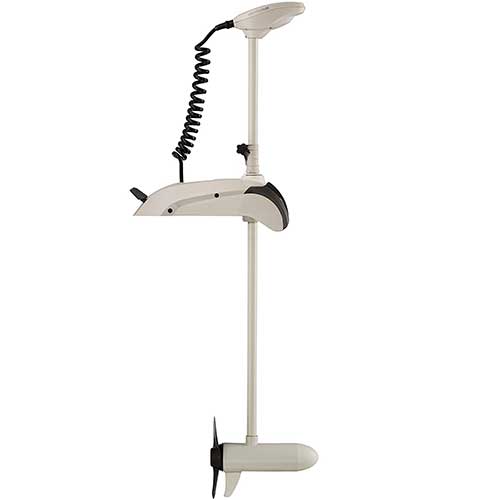
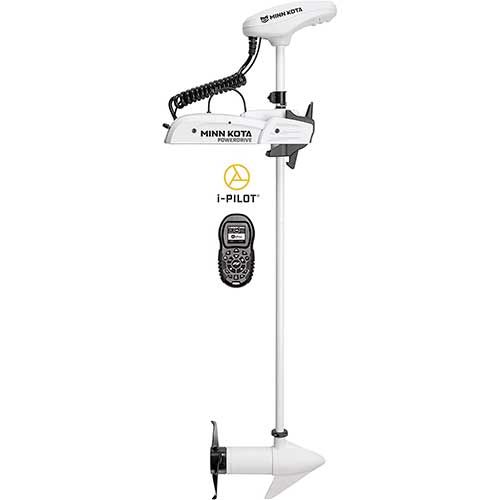
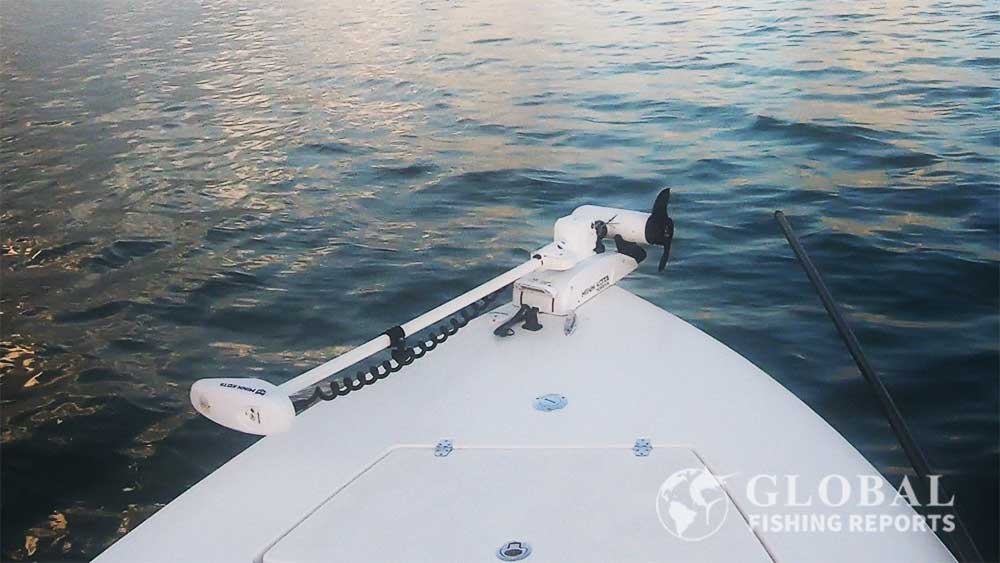
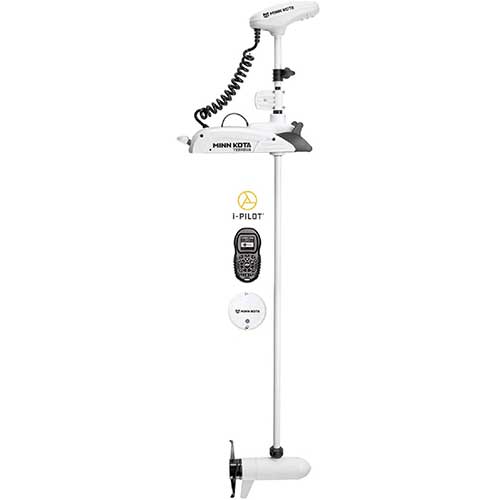
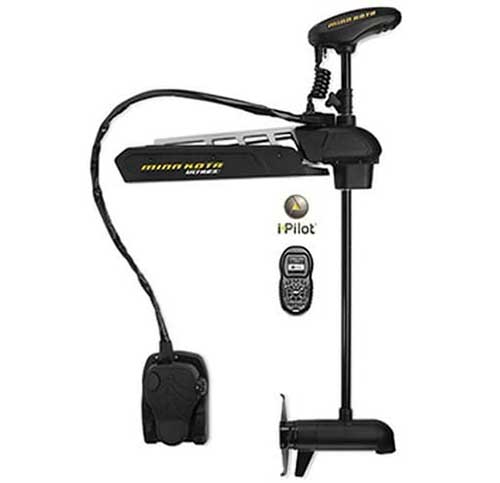
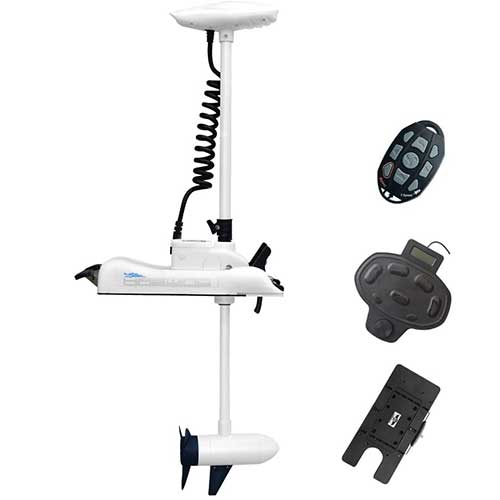
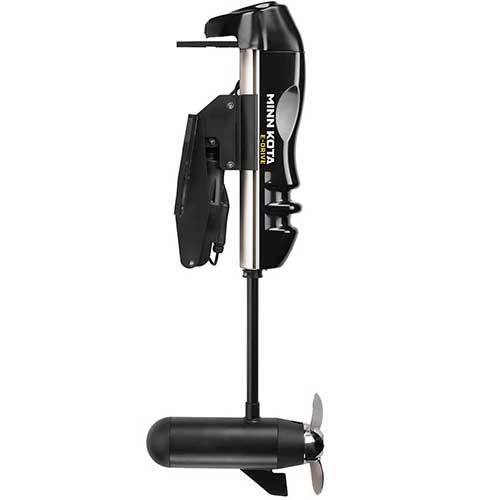

I think it might be time to get a new battery and possibly a new trolling motor.
I use my 16 ft alum (heavy gauge) in local lakes and the trolling motor will be used from and to the boat launch. What battery is the best to use that will be under pressure all day long. And can it be charged to 100% overnight? Money is an issue as well.